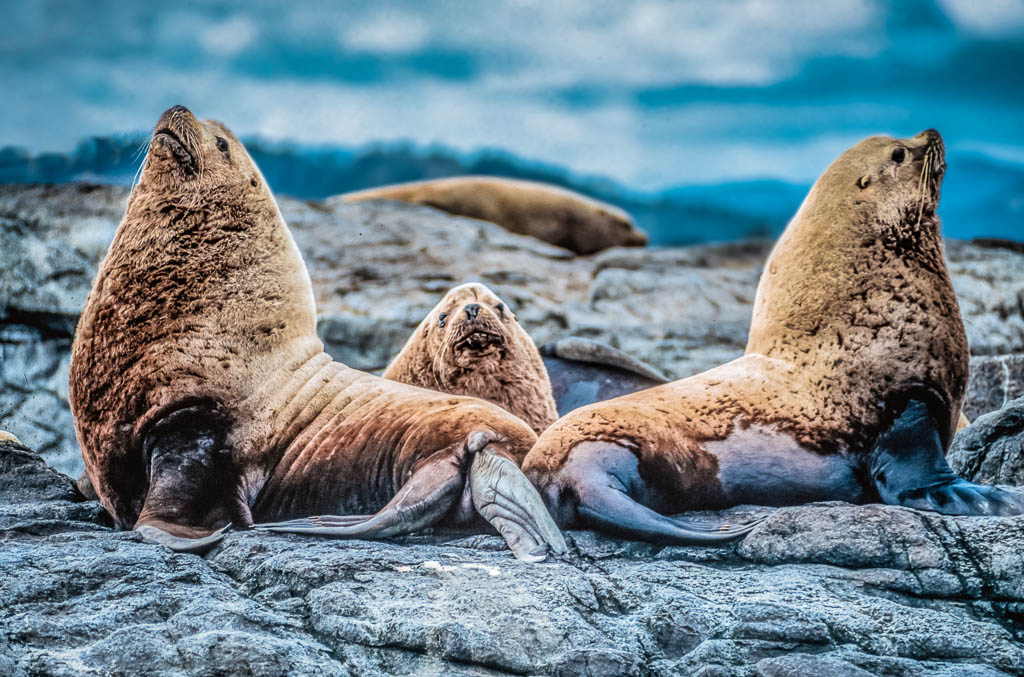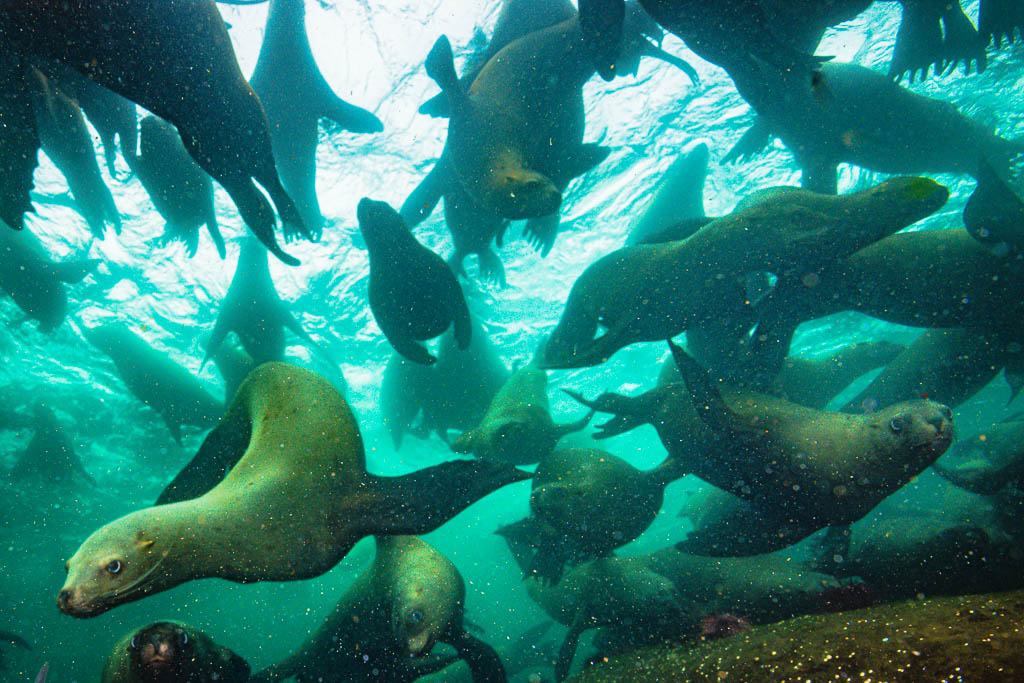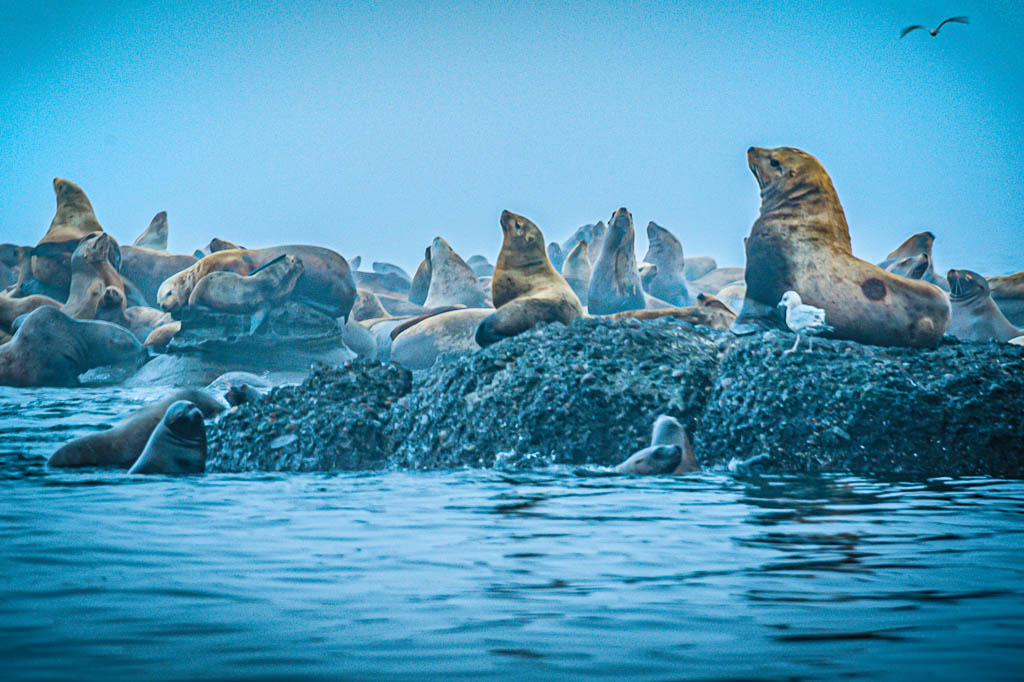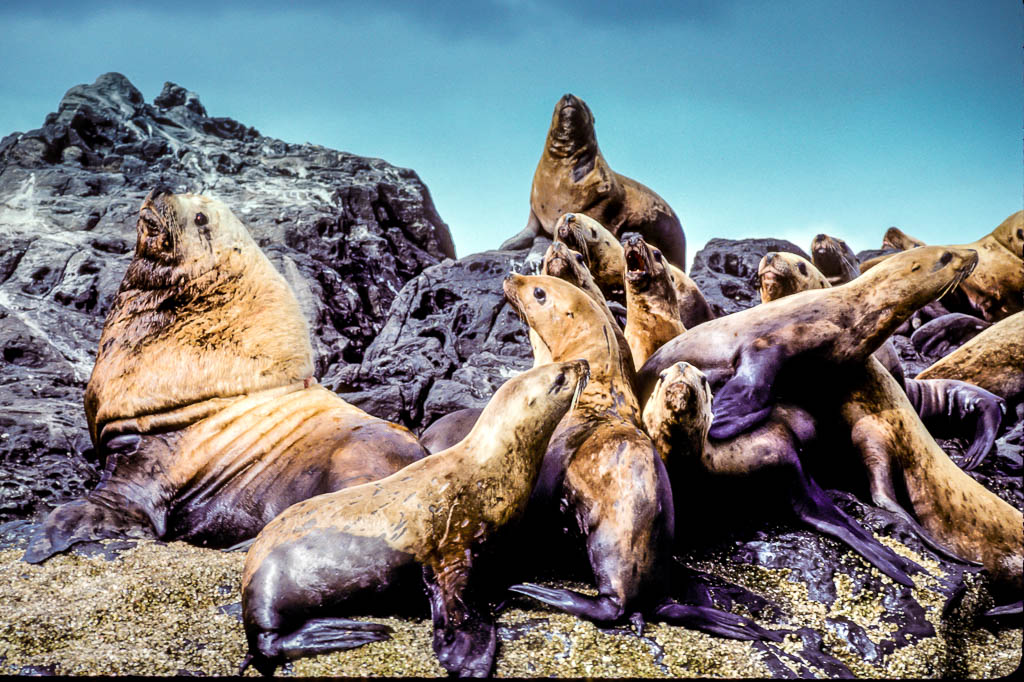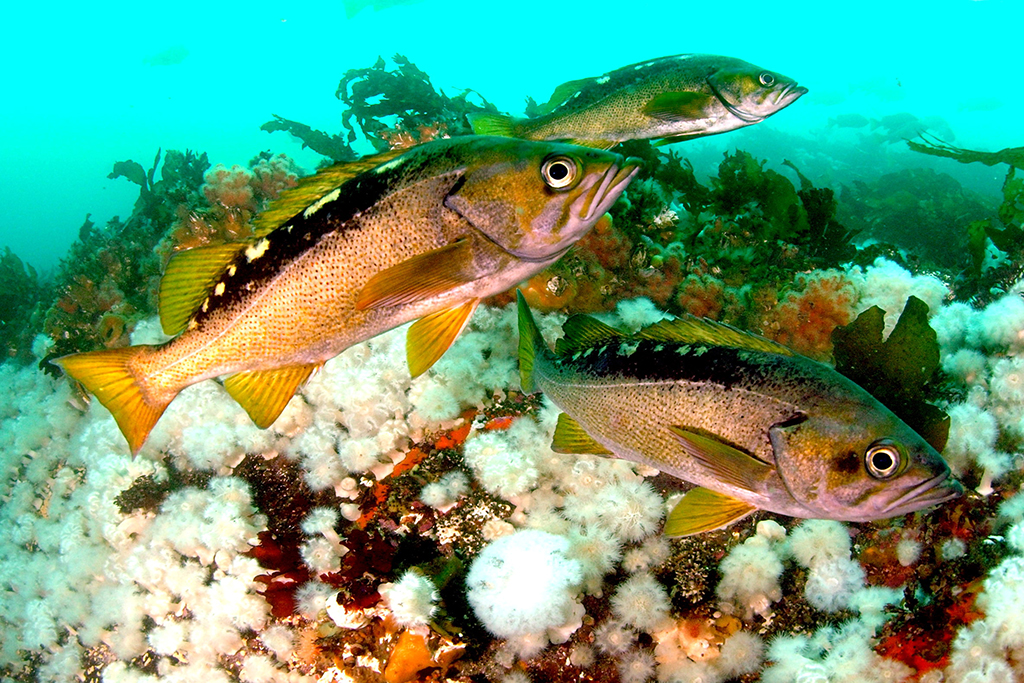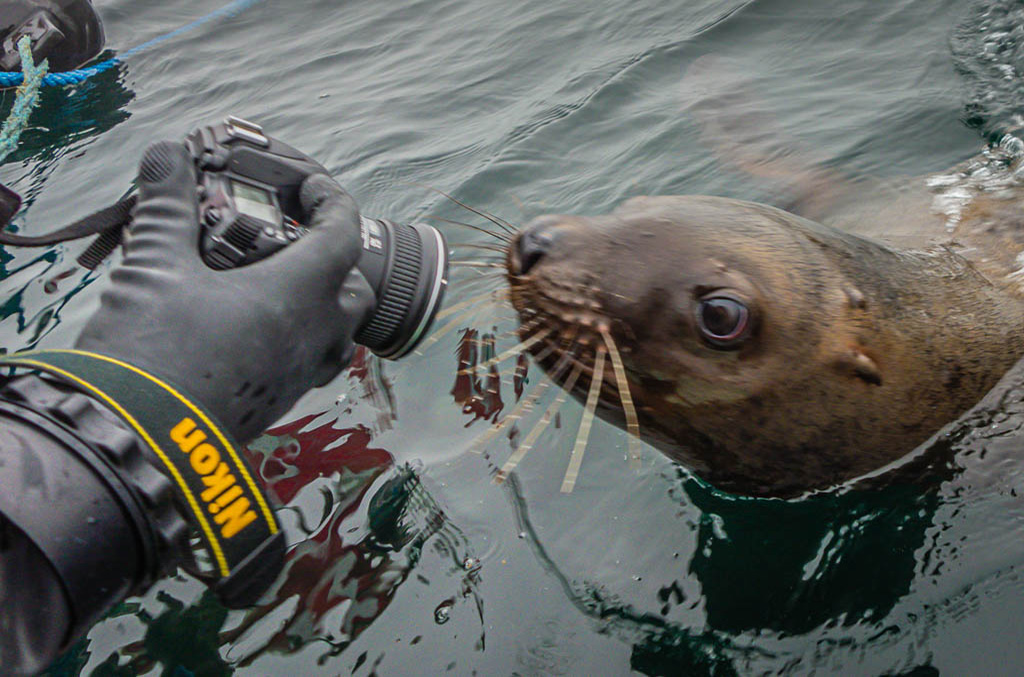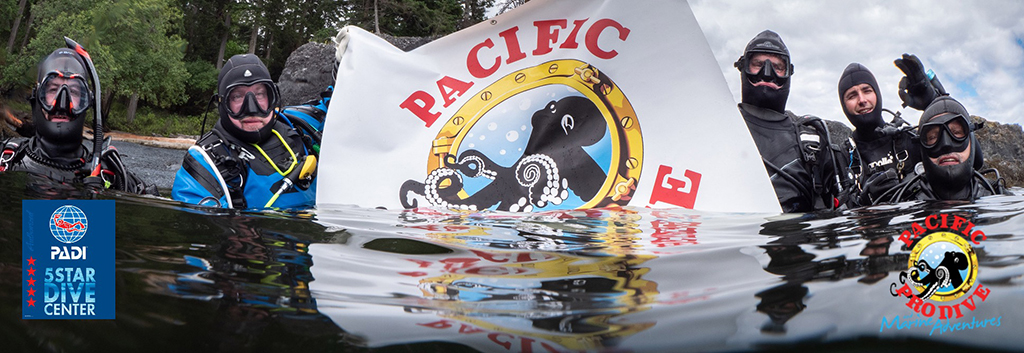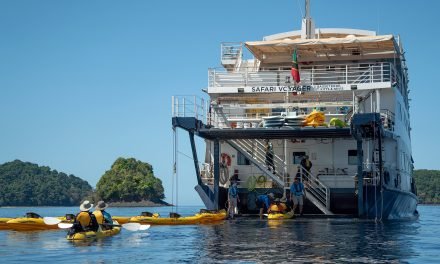
Into the Sea Lion’s Den
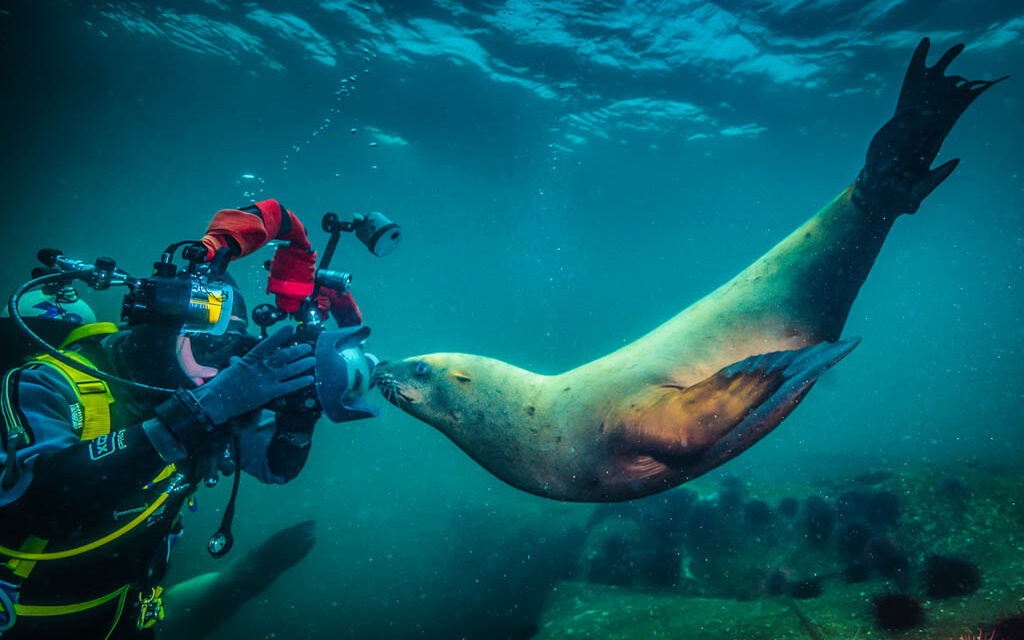
“Observing these magnificent prima ballerinas underwater is akin to having a front row, center seat, to an aquatic dance.”
Signaling our arrival at Norris Rocks, a chain of wave-lashed rocky islets situated off Hornby Island, on the eastern edge of Vancouver Island, we’re hailed with a cacophonous choir of guttural barks. The large colony of Steller sea lions hauled out on these barren rocks were seemingly voicing their excitement over our presence. Chilling our bones, a snarling winter wind competed with the pinniped’s raucous chorus as we dropped anchor 100 meters away from the nearest rocky outcrop. Several sea lions waded into the ocean and were now frolicking around our vessel, salaciously beckoning us into the sea lion’s den.
DANCES WITH SEA LIONS
After splashing into the ocean, we quickly descend 10 meters and kneel down upon the rock-strewn seafloor. At the edge of underwater visibility, we could make out some torpedo-shaped silhouettes. Suddenly, from out of the emerald haze more than 20 female sea lions appeared. Glancing over at my dive buddy, I could see a young female sea lion inquisitively peering into his underwater camera system’s dome port. Two coquettish sea lions stop to pose right in front of me as third one mischievously yanked on one of my fins. Then as quickly as they had arrived, the sea lions exploded towards the surface while unleashing a whimsical series of un-choreographed pirouettes, dramatic turns and topsy-turvy spins. Soon enough, they returned to swarm us again and again.
Observing these magnificent prima ballerinas underwater is akin to having a front row, center seat, to an aquatic dance. Breakneck swimmers, Steller’s can swim in burst speeds up to 50 kilometers per hour, but generally cruise at about 18 kilometers per hour. They generate speed by leaping clear of the water in a maneuver called porpoising, and then glide near the water’s surface to minimize resistance. The bone structure of their wing-like front flippers is similar to those found in human arms and hands. Quite literally, they fly through the water by making long simultaneous sweeps with their front flippers and use their hind limbs for steering. Remarkably, they are quite mobile over rocky terrain since they are able to rotate their hind flippers underneath their body enabling them to shuffle-walk by using all four limbs.
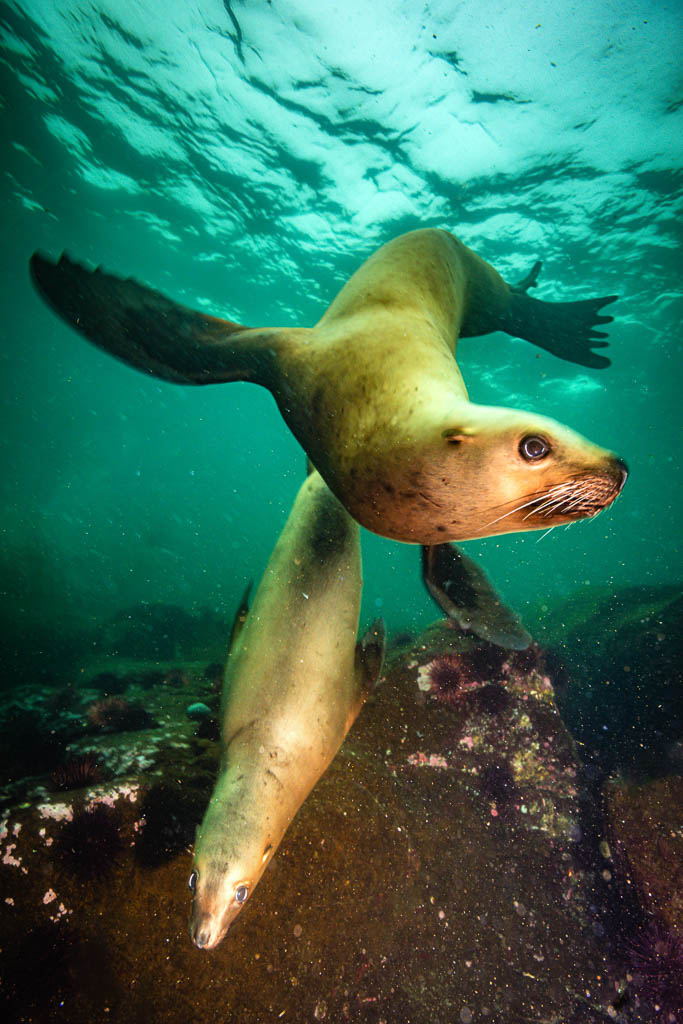
Two coquettish sea lions stop to pose right in front of me as third one mischievously yanked on one of my fins.
While they generally only make brief two to six-minute forays underwater, Steller sea lions possess the ability to dive as deep as 450 meters and remain submerged for up to 20 minutes on a single breath of air. Unlike true seals, that empty their lungs before diving, sea lions only partially deflate their lungs, allowing them to vocalize underwater. This ability to bark and grunt when submerged is used by males when patrolling their undersea domain. When submerged, oxygen in the sea lion’s body is shunted to vital organs such as the heart and central nervous system rather than non-vital organs. Marine biologists speculate this physiological response may prevent the formation of gas bubbles which triggers decompression sickness, otherwise known as “the bends”.
WORLD’S LARGEST SEA LION
Highly gregarious by nature, Steller sea lions (Eumetopias jubatus) were named after Georg Wilhelm Steller, the eminent German naturalist who accompanied famed Russian explorer, Vitus Jonassen Bering, on his second Alaskan expedition to Kamchatka Peninsula in 1741. During a long winter shipwrecked on Bering Island, Steller became the first scientist to study and classify what turned out to be the world’s largest sea lion. Steller thought the males resembled an African lion because the bull’s enormous neck and shoulder region were reminiscent of a lion’s thick mane of coarse hair. Females, or cows, look significantly different from males in that they noticeably lack a fluffy lionesque mane of hair around their necks. Males weigh in between 700 to 1,000 kilograms, with a three-metre body length. Females are about one third as large, tipping the scales at 300 kilograms and grow to approximately two metres in length. The fur of both sexes is buff-coloured tan to reddish brown with slightly darker shades on their chest and abdomen region. Pups are chocolate brown to black for up to six months after birth, by which time their fur molts to a lighter colour.

With thick, hairy necks that look like a lion’s mane, a male Stellar sea lions’ skull, jaw & teeth are almost indistinguishable from those of a large Grizzly bear, along with their BIG strong teeth!
Ranging throughout the Pacific Rim’s coastal waters from Japan to central California, it’s estimated approximately 70 percent of theses sea mammals reside in Alaska. British Columbia’s Steller sea lion population fluctuates somewhere between 34,000 sea lions during the summer breeding season, increasing to 55,000 during winter. British Columbia’s Stellers continuously occupy about 40 year-round haul-out sites for resting and five established rookeries to breed, give birth and rear pups. Situated on isolated islets and weather exposed islands, these haul-outs and rookeries all offer easy access to the open sea.
LOVE ON THE ROCKS
Steller sea lions are colonial breeders, which means one bull male breeds with many females. In early May, one of nature’s great spectacles unfolds as dominant mature males who are between nine or 10 years old begin arriving at the rookeries intent on reclaiming the same piece of territory they occupied in previous years. They will not eat for roughly 40 days, both to defend their breeding territories on rookeries and to ensure none of the fifteen to thirty females in their harem don’t run off to copulate with a rival bull. Roaring and hissing between rival males can quickly escalate into bellicose chest-to-chest battles with open mouths that may result in severe injury. Upon reaching the advanced age of 13 to 15 years old, these dominant bulls will be unable to compete with younger and stronger rivals and will have to surrender their patch of land for a less sought-after location in the rookery. In other words, the male who can claim and defend the best breeding real estate ends up with the most females.
After an 11 ½ month gestation period, females return to traditional rookeries between mid-May to early June to give birth to a single pup weighing between 16-23 kilograms. Mothers stay close to their pup to nurse for one to two weeks before gradually spending more time away from land to hunt at sea. Nursing generally continues for just under a year, but may continue for as long as two to three years. Females recognize their pup’s scent and vocalizations and will reject any pup who is not their own by either biting them or tossing them away. Mating resumes with a dominant male 10 to 14 days after the females have berthed their pup.
PREDATORS & PREY
Steller sea lions are opportunistic marine carnivores who prefer to forage alone at night, but by day will hunt schooling fish in groups of up to 100, or more. They prey on a wide variety of fish species such as Pacific herring, salmon, mackerel, sand lance, white capelin, pollock, Pacific cod, ratfish, rockfish, and will also devour squid, octopus, crustaceans, skate, dogfish (small sharks), seabirds and periodically, small pinnipeds. Stellers are non-migratory and seldom roam far from shore other than to make some well-defined local seasonal movements to different feeding and haul-out areas. They will also swim as far as 150 kilometers offshore in search of prey.
A diet containing fattier fish, such as Pacific herring, is critical to the maintenance of sea lion blubber. And herein lies another problem. Steller sea lions must maintain a thick blubber layer to help them to maintain a high body temperature while swimming in cold Pacific waters. Oil secreted into the sea lions tightly packed fur helps keep their skin relatively dry, even when submerged underwater. This natural layering of blubber, fur, and oil helps to retain body heat. While they must consume on average about six percent of their body weight each day, Steller sea lions don’t need to drink water as they absorb all the fluids, they need from the food they eat. Curiously, the stomachs of many adult sea lions contain stones! These rocks vary in size from small pebbles to 12 centimetres in diameter. No one has ascertained whether these stones are swallowed by accident during play or if they serve a useful purpose such as; grinding up fish in their stomachs, providing ballast when diving, or to help ward off hunger pangs when they are fasting on shore.
Sea lions are an important prey species for pinniped-eating transient killer whales, other natural predators include salmon sharks, great white sharks and Pacific sleeper sharks. Human activities, however, pose an ever-present threat to Steller sea lions from injuries or death caused by boat strikes, pollutants, habitat degradation, oil spills, entanglement in fishing equipment or nets, illegal hunting, over-fishing and more recently outcries by some for systematic culling to save other species who compete with sea lions for food.
TO CULL, OR NOT TO CULL?
Culling one species to save another species is a controversial issue with arguments for and against. Commercial fishers in British Columbia point the finger of blame at sea lions for eating too many fish. Of course, there is no scientific evidence that supports or justifies that a sea lion cull would provide a quick fix for province’s unbalanced ocean ecosystem. What marine scientists know for sure is, four of the province’s five major herring populations have been closed. In the Strait of Georgia, the fifth remaining open herring fishery, conservation groups cast blame on over-fishing for reducing the once mighty annual Pacific herring spawn to an 80 kilometer stretch of Salish Sea coastline between Comox and Parksville. When sea lions and endangered Chinook salmon congregate here to feast upon herring, one of their principal food supplies, they must both compete against the commercial seine and gillnet fishing fleet for an increasingly scarce resource. Amid recent reports that the at-risk Southern resident killer whales are now starving to death because of the drastic decline in BC’s iconic Chinook salmon population.
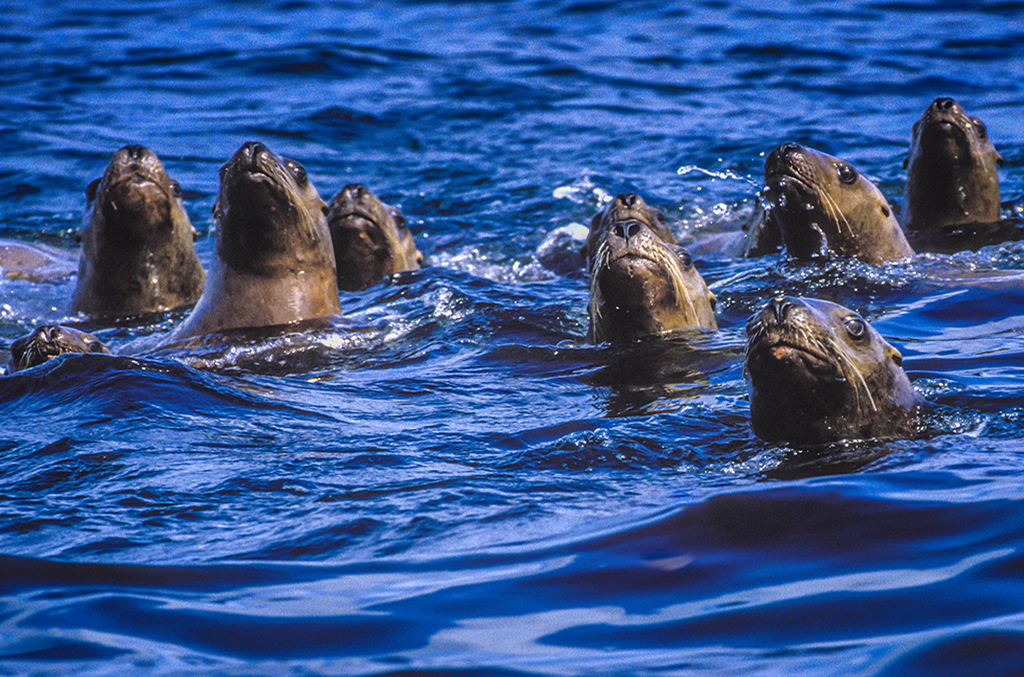
Since British Columbia’s Steller sea lions became a protected species in 1970, their population is deemed to have now returned to historical levels.
The call to cull Steller sea lions provides an unnecessary distraction from the real problem; the ongoing fierce competition for diminishing food resources negatively impacting numerous marine species. Global warming combined with a tangled web of biological, environmental, and human activities has resulted in an unbalanced marine ecosystem which negatively affects the ocean’s food web. While the impact of all these threats remains poorly understood, Fisheries Canada has stated, “With the recent shift toward ecosystem-based management there may be potential for using species like the Steller sea lion as a general indicator of the status of food webs in the North Pacific.” Ecosystem-based Management is an environmental methodology that considers the full scope of all species interactions within an ecosystem, including human activities, as opposed to only studying single issues, species, or coastal marine ecosystems in isolation.
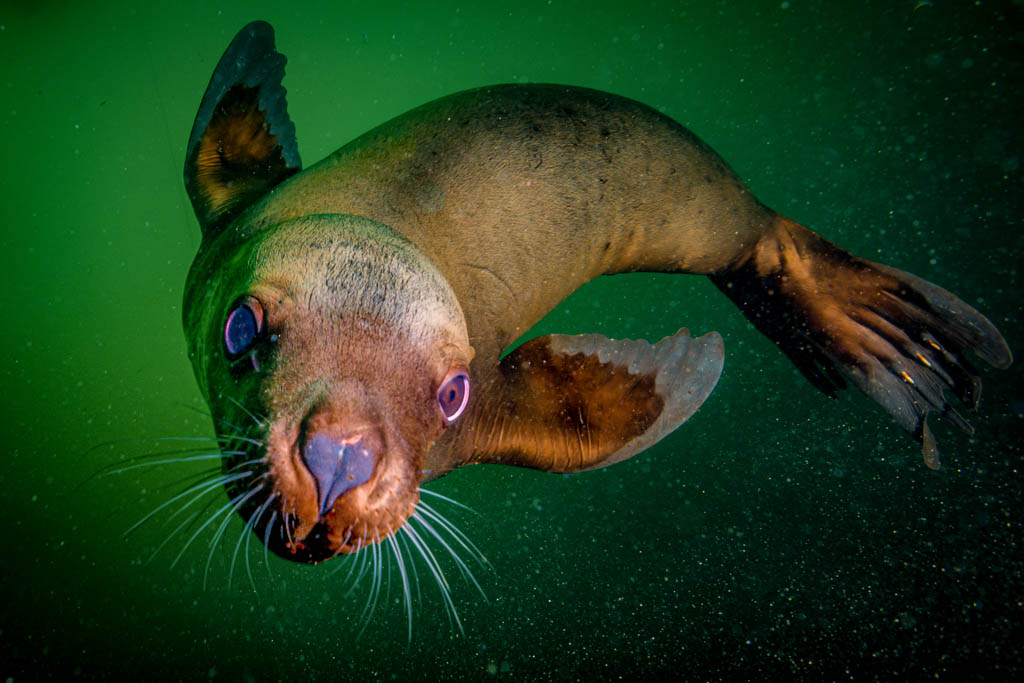
Steller sea lions must maintain a thick blubber layer to help them to maintain a high body temperature while swimming in cold Pacific waters.
During the mid 20th century, BC’s Steller sea lion population was severely reduced when they were culled in an effort to protect salmon stocks. Fortunately, they have been fully protected throughout much of its range for several decades, and the province’s sea lion population is deemed to have now returned to historical levels, yet they are still considered to be near threatened with extinction. Yes, along with a diminishing food source, the impact of sea level rise caused by climate change may directly impact the Steller sea lions terrestrial haul-out sites and rookeries.
ARE SEA LIONS DANGEROUS?
One must always remain situationally aware when in close proximity to any large ocean predator. On the surface they are cautious animals and when approached it will trigger either a fight-or-flight response. Underwater they own the liquid stage and seem to take great delight in interacting with scuba divers, mimicking our behaviours, and giving playful tugs on limbs and scuba gear. Socially inquisitive, these pinnipeds are not predisposed to acting aggressively or causing any physical harm to divers. Female sea lions may occasionally bluff-charge divers by blowing bubbles and rush towards them at speeds of 30 kilometres an hour before gracefully veering off at the very last second. Their skulls are similar to those of North American Grizzly bears and their jaws contain sharp canine teeth. When they playfully gnaw divers, it feels more like a mild jerk, or a firm pull. This gentle physical curiosity seems to affirm that a sea lion’s bark is worse than their bite.
CLOSE ENCOUNTERS OF THE BLUBBERY KIND
Diving in the wild with blubbery Steller sea lions offers scuba divers thrilling close encounters that’s on par with diving with dolphins, sharks or whales in tropical seas. One cannot help but marvel at a sea lions graceful swimming ability and their seemingly childlike penchant for aquatic fun. The underwater images we are able to capture provides but a fleeting glimpse into the sea lion’s den, an aquatic realm where winter’s biting chill is warmed by blowing bubbles with Steller sea lions within British Columbia’s Emerald Sea.
Until our next dispatch, dare to Explore…Dream…Discover.
SCUBA DIVING OPERATORS
The following four scuba diving operators on Vancouver Island all conduct day and multi-day diving and snorkeling trips with Steller sea lions. Check with the operator to determine if the sea lions are around or in season.
UB Diving
Hornby Island Diving
http://hornbyislanddiving.com/
Pacific Pro Dive
Big Animal Encounters
https://biganimalencounters.com/










